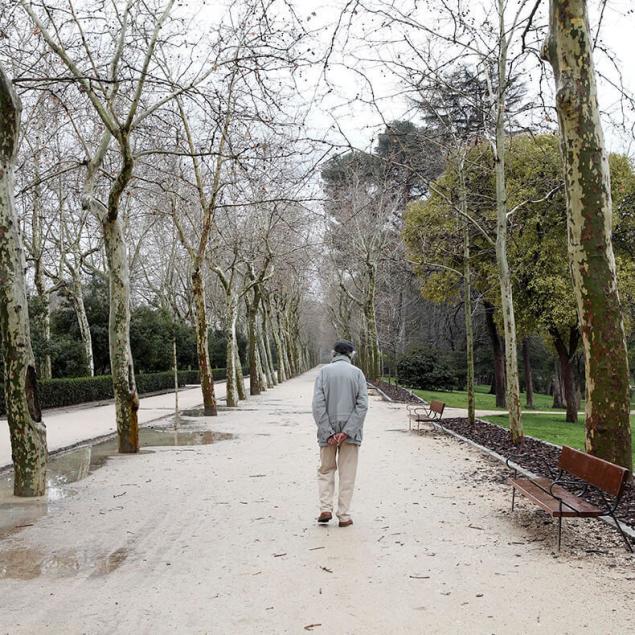880
Clinical psychologist: what happens to us with age
We publish the text of the lecture clinical psychologist Ilya Pluzhnikov the aging person in terms of neuropsychology - the science that through the analysis of the brain explains what happens to a person, what styles are aging, and why older people is better to speak in a low voice.

What is man aging, and that - is growing? In the lecture, I do not focus on biochemical and morphological aspects, namely, the person - in the process of individual development of the person, because it never stops. I do not think that after adolescence man reaches a plateau, as the scientists call "Acme", the highest point of development, and then degraded. Aging is not a degradation. This process of continuing development, it is very peculiar.
Normal aging, according to our psychological school - it is a process of continuous, progressive, non-uniform, comprehensive growth of different restrictions. There is a purely physiological: decreased hearing, there are specific forms of diseases, which are actually not a disease, and there are normal symptoms of aging-related movements, muscles, sensory systems, psychology and so on, and, of course, there are social restrictions, which in the individual consciousness aging man refracted and become existential.
The unevenness of the process and creates individual differences. Modern methods of scientific research, are prone to statistical processing and quantitative analysis of the data, unfortunately, does not help to reveal the essence of the mechanisms that lie behind it, because aging is very individual.
Why?
If we speak rather crudely, it's a baby. As soon as he is born, he immediately falls into society, where care for him, but the nature is arranged so that the genetics of the new man is put a certain program, which gives it a minimum range that he survived.
Therefore, early ontogenesis, ie, early individual differences from birth to pre-school age, are programmed enough. We know the rules: when a child should be able to hold his head, say the first word, what kind should be those words when he should appear Phrase speech, when he must begin to walk, crawl, and so on
. If there are deviations in the regulations, we say that it is abnormal, pathological, with the need to do something - the correction must be medical, because these biological programs. In adulthood, the development has a more direct, social man takes his own activity, and so on
. He comes to the third age, that is, until the age of aging, with a already very serious baggage - knowledge, experience, experiences, psihotravm, beliefs, meanings and values. All this enormous baggage, of course, very much zashumlyaet natural biological program.
Therefore, the aging individual, precisely because of individual experience. Thus, we have obtained is not very good to find biological causes of natural-scientific methods. Therefore, all data on individual differences, which I will provide clinical. That is not collected on the sick, and by long-term, long-term observation - including our department and me
.
However, you can select individual differences, which we call the style or type of option, that is to allocate some of the normal aging typology based on the fact, how the brain.
In 30-50 years of the eminent Soviet scholar psychologist Alexander Luria opened the world of science, which he called neuropsychology. She was born in the Soviet Union and adopted worldwide. Indeed, this is our achievement, one of the few that is exactly our.
Luria's studies of patients with local brain lesions, presenting various kinds of tests shows that with the defeat of certain structures there are certain symptoms of the disorders of higher mental functions such as memory, thinking, attention, speech and so on. He concluded that if you give the patient a specific test that will demonstrate certain disorders of mental functions, then these areas and are responsible for the implementation of these mental functions.
Luria
In 70-80s student of Alexander Romanovich Luria Natalia K. Korsakov he began working at the Scientific Center of Mental Health, where she was offered to use the techniques Luria for the diagnosis of Alzheimer's disease, to understand how it affected the brain.
And indeed, showing the tests, lurievskie methods that have been developed for people with brain tumors, it shows that in patients with Alzheimer's disease appear very similar symptoms, similar also to those that occur in patients with tumors of the parietal, frontal lobe , temporal, subcortical brain structures.
Korsakov concludes that in Alzheimer's disease and other forms of dementia, severe mental disorders of old age there are specific cognitive impairments. This means that this pathological process is not a tumor, and atrophic, extends in each case at a different disease to certain areas of the brain. Thus was born the science neyrogerontopsihologiya.
Scientists began to wonder what was going on in old age in the norm. Having studied more than 300 healthy individuals from 50 to 100 years old, who have never treated for mental health and neurological problems to doctors, Korsakov highlights various neurocognitive styles, typology of normal aging. It shows how we age and our mind in connection with the operation of the brain. These data are indirectly confirmed by Western research using neuroimaging, functional tomography, positron emission tomography, and so on.
Normal aging is characterized by certain parameters, the main of which - the individual. This not only limits the growth, but also, most importantly, the update of compensatory strategies - strategies for coping with the limitations that arose
. They can be realized, "Well, I understand that it is time to write little notes, I do not remember" - or unconscious. The psyche is changing qualitatively. It is believed that during aging loss of memory, but the important thing is that normally there is a qualitative change memory, vector changes its operation. Do not desire to remember, the assimilation of new, as a young person, child or adult, and the vector back - to the witness, a deeper treatment to the experience, to analyze its deeper layers
. Why?
For the implementation of the main task - the transfer of meanings. Socio-psychological studies have shown that young teachers teach children differently than older. Not because they have more experience, not because of what they give more examples, but because they translate the values, meanings, and thereby perform the main task of development in later life. Do not receive, namely the transfer. No value, and the value-oriented things.
What is aging phenomenologically?
Firstly, of course, this slowdown in activity. Latency increases, people in the third age start to work more slowly. Especially it becomes apparent slowness in the initial phase of activity. Becomes especially difficult to quickly retrieve the information, link it. You must be able to negotiate with his memory after 55 years, so she gave out what you need.
Secondly, a person begins to work as a single-channel system. If he reads the newspaper, the TV does not hear and does not think about things that are not related to this newspaper.
Thirdly. With regard to the scope of the voice, to speak the elderly person must not only slow, but also in a low voice. Not necessarily loud, although age hearing loss can also occur, but the velvet baritone or bass is learned better than the tenor and falsetto. This is a purely sensory thing proven scientifically.
Fourth, the tempo performance. Voice data can be absorbed more slowly than non-voice. There is a certain imbalance, stealing from the right hemisphere to the left. The left hemisphere begins to work harder due to the fact that it may lose some right-brain functions. Nevertheless, it is not always enough and fragmented, so, for example, the music is well digested, and listening to the songs of youth actualizes the deep layers of memories.
Tactile sphere literally comes to life, so people love to touch things, dust, so the elderly is better to give gifts texture, textured - it also updates the thresholds of the memory layers
. About memory. Access to direct memories of what happened today, it becomes more closed. It opens access to early memories of youth, adolescence and even childhood. They become more vivid, distinct. Traces of memory are not erased: we all remember, we just have not always open to this access
. And finally, this reduced ability to learn new and difficulties with the production of creative tasks. Not because a person becomes feeble-minded, but because not enough energy to support the creative process, which, as you know from all metaphors, should gush.
The types of normal aging
This typology is based on the concept of Alexander Romanovich Luria about the structures of the functional units of the brain. he divided the brain into three blocks not on morphological structure on the basis of his many studies, and on the roles that the brain structures play for the implementation of higher mental functions.
Energy neurocognitive aging style
The most popular, universal. Is associated with reduced function of the energy provision of mental activity: people are slower, they observed the phenomenon of «on-off» - «on-off»
. That is, a person begins to read the book, it is difficult, not matter, closes, goes to the kitchen and helping his wife to cook soup, that is activated. These fluctuations can be observed mildly enough, they do not violate the adaptation. When vascular lesions of the brain, this effect can disturb her. That is, a person can not cope with the task in the «off» state and «on» condition may become too excited. That is crying, then laughing. There are clinical examples.
In addition, a narrowing of the scope of activity, perception of a single-channel system memory traces inhibited and fatigue - non-specific aging characteristics without risk factors. Most importantly, it works well cortex. That is, people can come up with yourself, learn from past experience to plan, for example, that the distance to the clinic he would take a time to visit and grandchildren, that need such operations; he can plan the day in a specific way. Inhibited, the unavailability of memories that are needed right now, mean that you need to record, and the person understands this.
Risk factors that may lead a person to maladjustment - is, of course, stress. Since the subcortical structures - it is emotion, stressorezistentnost, the ways of regulating their emotions is not enough. That is, there may act emotional problems.
This aggravation of bodily ailments. The most malignant, that really knocks the man out of the rut, and introduces him to a state of maladjustment, anxiety, depression - a femoral neck. Such a person needs special attention; possibly, professional psychological support. I'm not talking about cataracts and other age-pure thing - they, of course, also require special attention.
Spatial style neurocognitive aging
The second type - is reduced ability for targeting the real and the inner space. For a specific type of aging, in which it becomes very difficult to perceive different things holistically. Read a short story, and even to understand the essence, may already be a problem. It should first read one paragraph, to understand it, to remember to take a break, then the second and so on.
Technically, you can read the story, the man is exhausted, but he did not understand. And most importantly - a "disadaptative" in the new space. Please note, this is not a spelling mistake. That is, people are not lost at all, and it is difficult in the new space, he begins to grasp at the right hand, thinking: "The right hand - so I need to go to the right»
. They have a marker that really programmed: "I am writing with his right hand" - therefore you need to navigate to the right. They are a very long time may stray, but not in the sense that they are really lost, but because they occur in the new space this kind of difficulties. In the space of the old familiar things can be quite safely.
That is, the risk factors here - this change in the environment, such as emigration. Our colleagues, Russian psychologists abroad, one time out magazine articles devoted to Russian immigrants in France, the United States. They describe these phenomena is very big, and also in connection with the linguistic side. For example, the phenomenon of "pathological nostalgia": female immigrant believed that he was in his Moscow apartment, had seen people from that life. It was not hallucinating because of mental illness, but a temporary condition, stress, culture shock. This is associated with the right hemisphere.
It is important here to understand that this kind of thing can be very similar to Alzheimer's disease, but they need to be distinguished. Here are the statistics. Schizophrenia - 1%, but 10% - this is Alzheimer's disease, where 4% - this is early Alzheimer's. In our clinic, it's all women 40 years.
I remember the last case: 40 years old, nurse and truly serious symptoms associated with deep memory impairment. If you want to understand what it is, look amazing film "Still Alice" about early Alzheimer's. With maximum reliability shown what happens to a man with a deep psychological penetration into the essence of this painful condition.
After 55-60 years - it's the classic Alzheimer's, and later called senile (Latin for "old."). Scientists say that it is genetically programmed. Unfortunately, there are no methods to identify the risk of this disease in humans before disease occurs. Genetic constellation leads to an imbalance of acetylcholine and other neuropeptides, which leads to the formation of Alzheimer's cells, i.e. atrophy of nerve cells in certain sections, with the result that these cells do not work and poor brain functions.
Alzheimer's disease is not treated: all the preparations that are assigned, are symptomatic and not much improve the condition of mental functions. And even more so, unfortunately, does not prevent further malignancy (after onset of the disease man does not live more than 10 years).
This rough exhaustion, that is, a person can not actively work for 45 minutes, gross impaired memory, inability to remember the material, disorientation in space, confusion, ie a person can not understand where he is, on the street or at home.
You could once see on the street grandfather in sneakers with a completely confused expression on his face, sometimes screaming, trying to call for help. Of course, this is not a reason to put him a diagnosis of "Alzheimer's disease", but it is a pathological condition that often accompanies it.
At the forefront spatial disturbances, that is, people can not remember where the toilet, where the kitchen. But it is worth noting that their identity is preserved facade, they are experiencing this condition, they are critical of him. Probably, all the tragedy lies in the fact that they understand that they lose what constitutes their identity. Because, according to one of the founders of Russian psychology, Sergey Leonidovich Rubinstein, one of the central functions of memory - it is the structuring of the individual. If the memory decays, disintegrates all our experience, experience with our personality, that is, the person goes.
Regulatory neurocognitive aging style
This is not a pathology, but really risky option when the first age anterior cerebral hemispheres. Here there is a decline in self-control. This is the central symptom, because the frontal lobes are involved. Luria calls the third function block brain programming unit, regulation and control of mental activity, so there is regulation and control are affected primarily.
When they are a little bit weaker, it is still the norm - what we in everyday life call "gray in his beard, a lusty": a person over 60, and he said that he, as the young can carry out their work, to behave as a young, одеваться в рваные джинсы, ходить с плеером, говорить: «Я Диму Билана слушаю, не буду же я Шульженко с Утесовым слушать, я еще не такой старый». Может быть и сексуализация поведения.
В деятельности могут быть проблемы с выстраиванием планов, застревание на каких-то моментах, негибкость. Апатичность, нарушение и снижение мотивации, которая еще должна сохраняться. В том числе мотивация к передаче смыслового ценностного опыта другим поколениям: «Ну, что я буду внуку звонить, я ему не нужен. Что я его буду доставать». Переживание неуспеха, одиночество, изменение условий жизни — все это может быть фактором риска. Могут последовать эмоциональные, брутальные реакции. На фоне стресса пожилой человек может думать: «А что это, сын приходил, он украл мой паспорт. Я не могу найти паспорт, потому что он приходил, он что-то хочет со мной сделать». То есть бредовые идеи возникают, но на фоне какого-то стресса.
Крайним случаем, патологическим прототипом здесь является болезнь Пика — тоже такое классическое заболевание, полюс болезни Альцгеймера. Если там фасад личности сохраняется, а человек осознает и страдает от нарастающих когнитивных нарушений, то при болезни Пика (или, как сейчас принято говорить по новомодной психиатрической классификации, при лобно-височной деменции) дисфункциональны передние отделы коры больших полушарий головного мозга.
Такие больные эмоционально притуплены, пассивны, безразличны, бездеятельны, лежат, ничего не делают. Они обеднены в моторике, письме, чтении, счете и не критичны к тому, что происходит, а происходит у них эйфория, они благодушны, могут смеяться. В то же время они абсолютно бездеятельны, пусты, утрачиваются морально-этические установки.
Могут быть стереотипии, персеверации, то есть навязчивые действия, и грубые когнитивные нарушения, то есть нарушения речи, грамматического строя, обеднение речевой продукции, нежелание говорить, выстраивать развернутое высказывание и так далее. В первую очередь и в начале появляется вот эта эмоционально-личностная дисфункция, на поздней стадии присоединяются уже какие-то когнитивные нарушения. Вот это уже дезадаптация.
Что предотвращает патологическое старение?
Люди, которые занимались интеллектуальным трудом на протяжении жизни, болеют деменциями позднего возраста меньше. Отдельно разработаны технологии гимнастики для мозга, то есть если уже возникают какие-то ограничения в когнитивной сфере, то можно обратиться к психологам, которые разработают индивидуальную программу тренировки. Конечно, я знаю стариков, которые учат стихи сами.
Это как отдельная деятельность: встали, позавтракали, погуляли с собакой, потом пару часов на выучивание нового стихотворения, позвонили приятелю в Подмосковье, прочитали наизусть, поиграли в шахматы по телефону, что тоже хорошо, можно посмотреть, как соотносятся е2-е4, потом можно снова поесть, потом снова с собакой погулять. То есть это распланированная деятельность, где есть когнитивный и интеллектуальный компонент для поддержания тонуса. Тонус поддерживается таким образом — через интеллектуальную деятельность.
У людей, которые постоянно поддерживали физическую активность, снижается риск возникновения деменций позднего возраста вследствие того, что метаболизм лучше работает, а значит, атеросклеротические бляшки не формируются, сахар нормализуется и так далее. То есть вещи, связанные чисто с сосудами, уже не вносят патологического вклада.
Mode. Показано, что люди, употребляющие крепкие напитки, чаще болеют деменциями позднего возраста. Полезна так называемая средиземноморская диета: белки, морепродукты, фосфор, свежие овощи. Те, у кого четкий режим сна и бодрствования, болеют меньше.
А дальше — чистая психология. Люди, которые испытывали психотравмы и с этими психотравмами не обращались к специалисту, не изживали их, страдают чаще. Люди, которые испытывали много, но мини-стрессов, то есть у которых была активная деятельность, которые жили в постоянном стрессе, меньше болеют болезнью Альцгеймера и другими деменциями.
Люди рефлексивные (которые рефлексируют присущий им нейрокогнитивный стиль) могут использовать это. Как в примере с борщом. Если у него пространственный вариант, но он хорошо помнит, какие ингредиенты нужно класть. А у нее первый вариант, она этого не помнит, но у нее лобные доли сохранны, то есть она помнит порядок действий: сначала надо пассировать, потом выложить и так далее. И вот они вместе готовят борщ, потому что понимают, что приготовить его не вместе невозможно. То есть они по-настоящему вносят свежесть в свои отношения, потому что они выходят на новый уровень. У них формируется совместная деятельность, которой не было.
И наконец, возможность реализации задач развития. Конечно, вы прекрасно понимаете: счастливы те старики, у которых есть внуки. Одиночество рождает все эти формы дезадаптации. Даже если перед нами одинокий представитель третьего возраста, но у него есть все это (то есть он был интеллектуально активен, он рефлексирует, что с ним происходит), то он сможет найти стратегии компенсации за счет чисто социальных вещей вроде клубов или социальных программ.

What is man aging, and that - is growing? In the lecture, I do not focus on biochemical and morphological aspects, namely, the person - in the process of individual development of the person, because it never stops. I do not think that after adolescence man reaches a plateau, as the scientists call "Acme", the highest point of development, and then degraded. Aging is not a degradation. This process of continuing development, it is very peculiar.
Normal aging, according to our psychological school - it is a process of continuous, progressive, non-uniform, comprehensive growth of different restrictions. There is a purely physiological: decreased hearing, there are specific forms of diseases, which are actually not a disease, and there are normal symptoms of aging-related movements, muscles, sensory systems, psychology and so on, and, of course, there are social restrictions, which in the individual consciousness aging man refracted and become existential.
The unevenness of the process and creates individual differences. Modern methods of scientific research, are prone to statistical processing and quantitative analysis of the data, unfortunately, does not help to reveal the essence of the mechanisms that lie behind it, because aging is very individual.
Why?
If we speak rather crudely, it's a baby. As soon as he is born, he immediately falls into society, where care for him, but the nature is arranged so that the genetics of the new man is put a certain program, which gives it a minimum range that he survived.
Therefore, early ontogenesis, ie, early individual differences from birth to pre-school age, are programmed enough. We know the rules: when a child should be able to hold his head, say the first word, what kind should be those words when he should appear Phrase speech, when he must begin to walk, crawl, and so on
. If there are deviations in the regulations, we say that it is abnormal, pathological, with the need to do something - the correction must be medical, because these biological programs. In adulthood, the development has a more direct, social man takes his own activity, and so on
. He comes to the third age, that is, until the age of aging, with a already very serious baggage - knowledge, experience, experiences, psihotravm, beliefs, meanings and values. All this enormous baggage, of course, very much zashumlyaet natural biological program.
Therefore, the aging individual, precisely because of individual experience. Thus, we have obtained is not very good to find biological causes of natural-scientific methods. Therefore, all data on individual differences, which I will provide clinical. That is not collected on the sick, and by long-term, long-term observation - including our department and me
.

However, you can select individual differences, which we call the style or type of option, that is to allocate some of the normal aging typology based on the fact, how the brain.
In 30-50 years of the eminent Soviet scholar psychologist Alexander Luria opened the world of science, which he called neuropsychology. She was born in the Soviet Union and adopted worldwide. Indeed, this is our achievement, one of the few that is exactly our.
Luria's studies of patients with local brain lesions, presenting various kinds of tests shows that with the defeat of certain structures there are certain symptoms of the disorders of higher mental functions such as memory, thinking, attention, speech and so on. He concluded that if you give the patient a specific test that will demonstrate certain disorders of mental functions, then these areas and are responsible for the implementation of these mental functions.
Luria
In 70-80s student of Alexander Romanovich Luria Natalia K. Korsakov he began working at the Scientific Center of Mental Health, where she was offered to use the techniques Luria for the diagnosis of Alzheimer's disease, to understand how it affected the brain.
And indeed, showing the tests, lurievskie methods that have been developed for people with brain tumors, it shows that in patients with Alzheimer's disease appear very similar symptoms, similar also to those that occur in patients with tumors of the parietal, frontal lobe , temporal, subcortical brain structures.
Korsakov concludes that in Alzheimer's disease and other forms of dementia, severe mental disorders of old age there are specific cognitive impairments. This means that this pathological process is not a tumor, and atrophic, extends in each case at a different disease to certain areas of the brain. Thus was born the science neyrogerontopsihologiya.
Scientists began to wonder what was going on in old age in the norm. Having studied more than 300 healthy individuals from 50 to 100 years old, who have never treated for mental health and neurological problems to doctors, Korsakov highlights various neurocognitive styles, typology of normal aging. It shows how we age and our mind in connection with the operation of the brain. These data are indirectly confirmed by Western research using neuroimaging, functional tomography, positron emission tomography, and so on.
Normal aging is characterized by certain parameters, the main of which - the individual. This not only limits the growth, but also, most importantly, the update of compensatory strategies - strategies for coping with the limitations that arose
. They can be realized, "Well, I understand that it is time to write little notes, I do not remember" - or unconscious. The psyche is changing qualitatively. It is believed that during aging loss of memory, but the important thing is that normally there is a qualitative change memory, vector changes its operation. Do not desire to remember, the assimilation of new, as a young person, child or adult, and the vector back - to the witness, a deeper treatment to the experience, to analyze its deeper layers
. Why?
For the implementation of the main task - the transfer of meanings. Socio-psychological studies have shown that young teachers teach children differently than older. Not because they have more experience, not because of what they give more examples, but because they translate the values, meanings, and thereby perform the main task of development in later life. Do not receive, namely the transfer. No value, and the value-oriented things.
What is aging phenomenologically?
Firstly, of course, this slowdown in activity. Latency increases, people in the third age start to work more slowly. Especially it becomes apparent slowness in the initial phase of activity. Becomes especially difficult to quickly retrieve the information, link it. You must be able to negotiate with his memory after 55 years, so she gave out what you need.
Secondly, a person begins to work as a single-channel system. If he reads the newspaper, the TV does not hear and does not think about things that are not related to this newspaper.
Thirdly. With regard to the scope of the voice, to speak the elderly person must not only slow, but also in a low voice. Not necessarily loud, although age hearing loss can also occur, but the velvet baritone or bass is learned better than the tenor and falsetto. This is a purely sensory thing proven scientifically.
Fourth, the tempo performance. Voice data can be absorbed more slowly than non-voice. There is a certain imbalance, stealing from the right hemisphere to the left. The left hemisphere begins to work harder due to the fact that it may lose some right-brain functions. Nevertheless, it is not always enough and fragmented, so, for example, the music is well digested, and listening to the songs of youth actualizes the deep layers of memories.
Tactile sphere literally comes to life, so people love to touch things, dust, so the elderly is better to give gifts texture, textured - it also updates the thresholds of the memory layers
. About memory. Access to direct memories of what happened today, it becomes more closed. It opens access to early memories of youth, adolescence and even childhood. They become more vivid, distinct. Traces of memory are not erased: we all remember, we just have not always open to this access
. And finally, this reduced ability to learn new and difficulties with the production of creative tasks. Not because a person becomes feeble-minded, but because not enough energy to support the creative process, which, as you know from all metaphors, should gush.
The types of normal aging
This typology is based on the concept of Alexander Romanovich Luria about the structures of the functional units of the brain. he divided the brain into three blocks not on morphological structure on the basis of his many studies, and on the roles that the brain structures play for the implementation of higher mental functions.
Energy neurocognitive aging style
The most popular, universal. Is associated with reduced function of the energy provision of mental activity: people are slower, they observed the phenomenon of «on-off» - «on-off»
. That is, a person begins to read the book, it is difficult, not matter, closes, goes to the kitchen and helping his wife to cook soup, that is activated. These fluctuations can be observed mildly enough, they do not violate the adaptation. When vascular lesions of the brain, this effect can disturb her. That is, a person can not cope with the task in the «off» state and «on» condition may become too excited. That is crying, then laughing. There are clinical examples.
In addition, a narrowing of the scope of activity, perception of a single-channel system memory traces inhibited and fatigue - non-specific aging characteristics without risk factors. Most importantly, it works well cortex. That is, people can come up with yourself, learn from past experience to plan, for example, that the distance to the clinic he would take a time to visit and grandchildren, that need such operations; he can plan the day in a specific way. Inhibited, the unavailability of memories that are needed right now, mean that you need to record, and the person understands this.
Risk factors that may lead a person to maladjustment - is, of course, stress. Since the subcortical structures - it is emotion, stressorezistentnost, the ways of regulating their emotions is not enough. That is, there may act emotional problems.
This aggravation of bodily ailments. The most malignant, that really knocks the man out of the rut, and introduces him to a state of maladjustment, anxiety, depression - a femoral neck. Such a person needs special attention; possibly, professional psychological support. I'm not talking about cataracts and other age-pure thing - they, of course, also require special attention.
Spatial style neurocognitive aging
The second type - is reduced ability for targeting the real and the inner space. For a specific type of aging, in which it becomes very difficult to perceive different things holistically. Read a short story, and even to understand the essence, may already be a problem. It should first read one paragraph, to understand it, to remember to take a break, then the second and so on.
Technically, you can read the story, the man is exhausted, but he did not understand. And most importantly - a "disadaptative" in the new space. Please note, this is not a spelling mistake. That is, people are not lost at all, and it is difficult in the new space, he begins to grasp at the right hand, thinking: "The right hand - so I need to go to the right»
. They have a marker that really programmed: "I am writing with his right hand" - therefore you need to navigate to the right. They are a very long time may stray, but not in the sense that they are really lost, but because they occur in the new space this kind of difficulties. In the space of the old familiar things can be quite safely.
That is, the risk factors here - this change in the environment, such as emigration. Our colleagues, Russian psychologists abroad, one time out magazine articles devoted to Russian immigrants in France, the United States. They describe these phenomena is very big, and also in connection with the linguistic side. For example, the phenomenon of "pathological nostalgia": female immigrant believed that he was in his Moscow apartment, had seen people from that life. It was not hallucinating because of mental illness, but a temporary condition, stress, culture shock. This is associated with the right hemisphere.
It is important here to understand that this kind of thing can be very similar to Alzheimer's disease, but they need to be distinguished. Here are the statistics. Schizophrenia - 1%, but 10% - this is Alzheimer's disease, where 4% - this is early Alzheimer's. In our clinic, it's all women 40 years.
I remember the last case: 40 years old, nurse and truly serious symptoms associated with deep memory impairment. If you want to understand what it is, look amazing film "Still Alice" about early Alzheimer's. With maximum reliability shown what happens to a man with a deep psychological penetration into the essence of this painful condition.
After 55-60 years - it's the classic Alzheimer's, and later called senile (Latin for "old."). Scientists say that it is genetically programmed. Unfortunately, there are no methods to identify the risk of this disease in humans before disease occurs. Genetic constellation leads to an imbalance of acetylcholine and other neuropeptides, which leads to the formation of Alzheimer's cells, i.e. atrophy of nerve cells in certain sections, with the result that these cells do not work and poor brain functions.
Alzheimer's disease is not treated: all the preparations that are assigned, are symptomatic and not much improve the condition of mental functions. And even more so, unfortunately, does not prevent further malignancy (after onset of the disease man does not live more than 10 years).
This rough exhaustion, that is, a person can not actively work for 45 minutes, gross impaired memory, inability to remember the material, disorientation in space, confusion, ie a person can not understand where he is, on the street or at home.
You could once see on the street grandfather in sneakers with a completely confused expression on his face, sometimes screaming, trying to call for help. Of course, this is not a reason to put him a diagnosis of "Alzheimer's disease", but it is a pathological condition that often accompanies it.
At the forefront spatial disturbances, that is, people can not remember where the toilet, where the kitchen. But it is worth noting that their identity is preserved facade, they are experiencing this condition, they are critical of him. Probably, all the tragedy lies in the fact that they understand that they lose what constitutes their identity. Because, according to one of the founders of Russian psychology, Sergey Leonidovich Rubinstein, one of the central functions of memory - it is the structuring of the individual. If the memory decays, disintegrates all our experience, experience with our personality, that is, the person goes.
Regulatory neurocognitive aging style
This is not a pathology, but really risky option when the first age anterior cerebral hemispheres. Here there is a decline in self-control. This is the central symptom, because the frontal lobes are involved. Luria calls the third function block brain programming unit, regulation and control of mental activity, so there is regulation and control are affected primarily.
When they are a little bit weaker, it is still the norm - what we in everyday life call "gray in his beard, a lusty": a person over 60, and he said that he, as the young can carry out their work, to behave as a young, одеваться в рваные джинсы, ходить с плеером, говорить: «Я Диму Билана слушаю, не буду же я Шульженко с Утесовым слушать, я еще не такой старый». Может быть и сексуализация поведения.
В деятельности могут быть проблемы с выстраиванием планов, застревание на каких-то моментах, негибкость. Апатичность, нарушение и снижение мотивации, которая еще должна сохраняться. В том числе мотивация к передаче смыслового ценностного опыта другим поколениям: «Ну, что я буду внуку звонить, я ему не нужен. Что я его буду доставать». Переживание неуспеха, одиночество, изменение условий жизни — все это может быть фактором риска. Могут последовать эмоциональные, брутальные реакции. На фоне стресса пожилой человек может думать: «А что это, сын приходил, он украл мой паспорт. Я не могу найти паспорт, потому что он приходил, он что-то хочет со мной сделать». То есть бредовые идеи возникают, но на фоне какого-то стресса.
Крайним случаем, патологическим прототипом здесь является болезнь Пика — тоже такое классическое заболевание, полюс болезни Альцгеймера. Если там фасад личности сохраняется, а человек осознает и страдает от нарастающих когнитивных нарушений, то при болезни Пика (или, как сейчас принято говорить по новомодной психиатрической классификации, при лобно-височной деменции) дисфункциональны передние отделы коры больших полушарий головного мозга.
Такие больные эмоционально притуплены, пассивны, безразличны, бездеятельны, лежат, ничего не делают. Они обеднены в моторике, письме, чтении, счете и не критичны к тому, что происходит, а происходит у них эйфория, они благодушны, могут смеяться. В то же время они абсолютно бездеятельны, пусты, утрачиваются морально-этические установки.
Могут быть стереотипии, персеверации, то есть навязчивые действия, и грубые когнитивные нарушения, то есть нарушения речи, грамматического строя, обеднение речевой продукции, нежелание говорить, выстраивать развернутое высказывание и так далее. В первую очередь и в начале появляется вот эта эмоционально-личностная дисфункция, на поздней стадии присоединяются уже какие-то когнитивные нарушения. Вот это уже дезадаптация.
Что предотвращает патологическое старение?
Люди, которые занимались интеллектуальным трудом на протяжении жизни, болеют деменциями позднего возраста меньше. Отдельно разработаны технологии гимнастики для мозга, то есть если уже возникают какие-то ограничения в когнитивной сфере, то можно обратиться к психологам, которые разработают индивидуальную программу тренировки. Конечно, я знаю стариков, которые учат стихи сами.
Это как отдельная деятельность: встали, позавтракали, погуляли с собакой, потом пару часов на выучивание нового стихотворения, позвонили приятелю в Подмосковье, прочитали наизусть, поиграли в шахматы по телефону, что тоже хорошо, можно посмотреть, как соотносятся е2-е4, потом можно снова поесть, потом снова с собакой погулять. То есть это распланированная деятельность, где есть когнитивный и интеллектуальный компонент для поддержания тонуса. Тонус поддерживается таким образом — через интеллектуальную деятельность.
У людей, которые постоянно поддерживали физическую активность, снижается риск возникновения деменций позднего возраста вследствие того, что метаболизм лучше работает, а значит, атеросклеротические бляшки не формируются, сахар нормализуется и так далее. То есть вещи, связанные чисто с сосудами, уже не вносят патологического вклада.
Mode. Показано, что люди, употребляющие крепкие напитки, чаще болеют деменциями позднего возраста. Полезна так называемая средиземноморская диета: белки, морепродукты, фосфор, свежие овощи. Те, у кого четкий режим сна и бодрствования, болеют меньше.
А дальше — чистая психология. Люди, которые испытывали психотравмы и с этими психотравмами не обращались к специалисту, не изживали их, страдают чаще. Люди, которые испытывали много, но мини-стрессов, то есть у которых была активная деятельность, которые жили в постоянном стрессе, меньше болеют болезнью Альцгеймера и другими деменциями.
Люди рефлексивные (которые рефлексируют присущий им нейрокогнитивный стиль) могут использовать это. Как в примере с борщом. Если у него пространственный вариант, но он хорошо помнит, какие ингредиенты нужно класть. А у нее первый вариант, она этого не помнит, но у нее лобные доли сохранны, то есть она помнит порядок действий: сначала надо пассировать, потом выложить и так далее. И вот они вместе готовят борщ, потому что понимают, что приготовить его не вместе невозможно. То есть они по-настоящему вносят свежесть в свои отношения, потому что они выходят на новый уровень. У них формируется совместная деятельность, которой не было.
И наконец, возможность реализации задач развития. Конечно, вы прекрасно понимаете: счастливы те старики, у которых есть внуки. Одиночество рождает все эти формы дезадаптации. Даже если перед нами одинокий представитель третьего возраста, но у него есть все это (то есть он был интеллектуально активен, он рефлексирует, что с ним происходит), то он сможет найти стратегии компенсации за счет чисто социальных вещей вроде клубов или социальных программ.
























